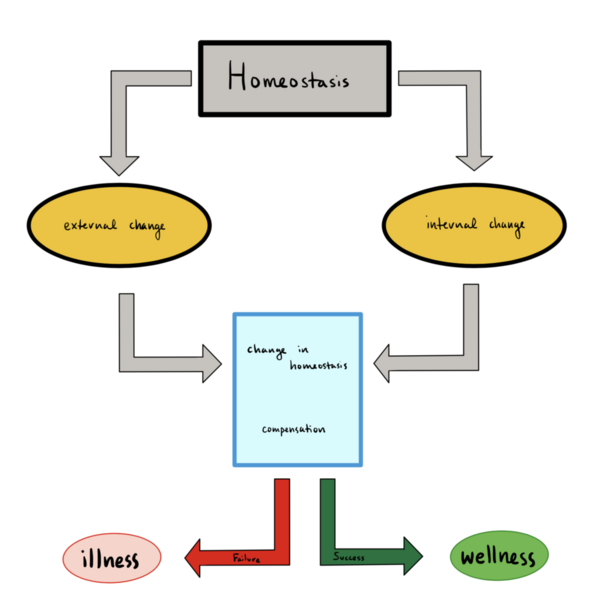Homeostasis
Original Editor - [[User:Lucinda hampton|Lucinda hampton
Top Contributors - Lucinda hampton
Introduction[edit | edit source]
Homeostasis, as defined thus "A self-regulating process by which biological systems maintain stability while adjusting to changing external conditions"[1]. Our bodies various functions must operate in a narrow range of balance internally, a dynamic equilibrium, in spite of a changing external environment. Our individual cells require our body to maintain these conditions to prevent the death of our cells, tissues and organs. [2]The body achieves this dynamic homeostasis by regulating temperature, glucose, toxins, blood pressure and pH.
Measures of homeostasis[edit | edit source]
Include:
- Our vital signs (blood pressure, core body temperature, heart rate, respiratory rate, and oxygen saturation) give an indication of a possible homeostatic imbalance.
- A basic metabolic panel can be done to show electrolyte disturbances.
When Homeostasis Fails[edit | edit source]
Homeostasis failure leads to many common disease processes. For example
- Diabetes
- Hypertension
- Fever
- With the normal aging process the body's ability to keep a steady homeostatis reduces, making older people more vunerable to disease. eg older people often find it harder to regulating their body temperature, they also have a harder time fighting infections and cancer.[3]
Exercise and Homeostasis[edit | edit source]
Exercise is a powerful modulator of metabolism and it is a large protective device protective agent staving of metabolic disease, due to exercises ability to boost metabolic function in multiple organs. For example exercise is a great regulator of insulin sensitivity and cardiovascular health.[4]
- bulleted list
- x
or
- numbered list
- x
References[edit | edit source]
- ↑ Billman GE. Homeostasis: the underappreciated and far too often ignored central organizing principle of physiology. Frontiers in physiology. 2020:200.Available:https://www.ncbi.nlm.nih.gov/pmc/articles/PMC7076167/ (accessed 1.4.2023)
- ↑ Libretti S, Puckett Y. Physiology, homeostasis.Available: https://www.ncbi.nlm.nih.gov/books/NBK559138/(accessed 1.4.2023)
- ↑ Libre texts Human biology Available:https://bio.libretexts.org/Bookshelves/Human_Biology/Human_Biology_(Wakim_and_Grewal)/21%3A_Disease/21.2%3A_Homeostasis_and_Disease (accessed 1.4.2023)
- ↑ Thyfault JP, Bergouignan A. Exercise and metabolic health: beyond skeletal muscle. Diabetologia. 2020 Aug;63:1464-74.Available: https://link.springer.com/article/10.1007/s00125-020-05177-6(accessed 1.4.2023)







